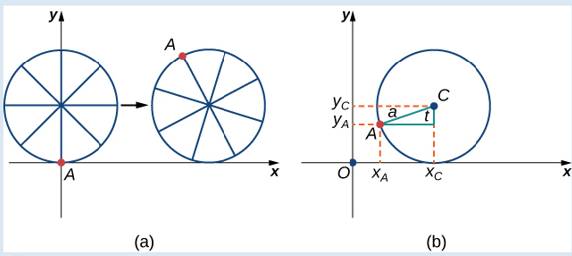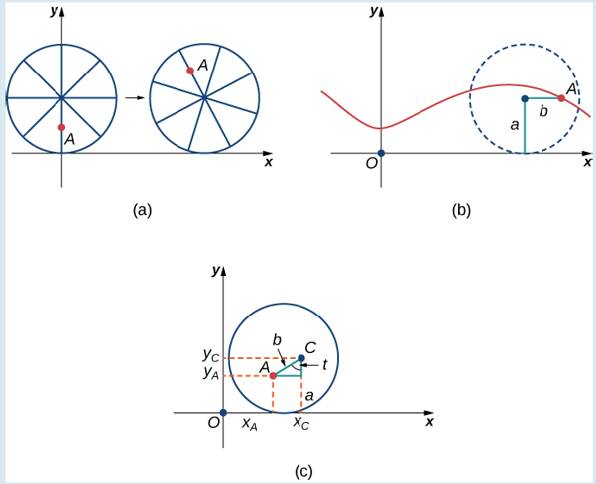
Travels with My Ant: The Curtate and Prolate Cycloids
Earlier in this section, we looked at the parametric equations for a cycloid, which is the path a point on the edge of a wheel traces as the wheel rolls along a straight path. In this project we look at two different variations of the cycloid, called the curtate and prolate cycloids.
First, let’s revisit the derivation of the parametric equations for a cycloid. Recall that we considered a tenacious ant trying to get home by hanging onto the edge of a bicycle tire. We have assumed the ant climbed onto the tire at the very edge, where the tire touches the ground. As the wheel rolls, the ant moves with the edge of the tire (Figure 7.13).
As we have discussed, we have a lot of ?exibility when parameterizing a curve. In this case we let our parameter t represent the angle the tire has rotated through. Looking at Figure 7.13, we see that after the tire has rotated through an angle of t, the position of the center of the wheel,
Furthermore, letting
Then

Figure 7.13 (a) The ant clings to the edge of the bicycle tire as the tire rolls along the ground. (b) Using geometry to determine the position of the ant after the tire has rotated through an angle of t.
Note that these are the same parametric representations we had before, but we have now assigned a physical meaning to the parametric variable t.
After a while the ant is getting dizzy from going round and round on the edge of the tire. So he climbs up one of the spokes toward the center of the wheel. By climbing toward the center of the wheel, the ant has changed his path of motion. The new path has less up—and-down motion and is called a curtate cycloid (Figure 7.14). As shown in the figure, we let b denote the distance along the spoke from the center of the wheel to the ant. As before, we let t represent the angle the tire has rotated through. Additionally, we let

Figure 7.14 (a) The ant climbs up one of the spokes toward the center of the wheel. (b) The ant’s path of motion after he climbs closer to the center of the wheel. This is called a curtate cycloid. (c) The new setup, now that the ant has moved closer to the center of the wheel.
5. What do you notice about your answer to part 3 and your answer to part 4?
Notice that the ant is actually traveling backward at times (the “loops” in the graph), even though the train continues to move forward. He is probably going to be real1y dizzy by the time he gets home!
Trending nowThis is a popular solution!

Chapter 7 Solutions
Calculus Volume 2
Additional Math Textbook Solutions
Elementary Statistics (13th Edition)
A Problem Solving Approach To Mathematics For Elementary School Teachers (13th Edition)
Thinking Mathematically (6th Edition)
Elementary Statistics: Picturing the World (7th Edition)
Calculus: Early Transcendentals (2nd Edition)
A First Course in Probability (10th Edition)
- 7. (a) (i) Express y=-x²-7x-15 in the form y = −(x+p)²+q. (ii) Hence, sketch the graph of y=-x²-7x-15. (b) (i) Express y = x² - 3x + 4 in the form y = (x − p)²+q. (ii) Hence, sketch the graph of y = x² - 3x + 4. 28 CHAPTER 1arrow_forward- (c) Suppose V is a solution to the PDE V₁ – V× = 0 and W is a solution to the PDE W₁+2Wx = 0. (i) Prove that both V and W are solutions to the following 2nd order PDE Utt Utx2Uxx = 0. (ii) Find the general solutions to the 2nd order PDE (1) from part c(i). (1)arrow_forwardSolve the following inhomogeneous wave equation with initial data. Utt-Uxx = 2, x = R U(x, 0) = 0 Ut(x, 0): = COS Xarrow_forward
- Could you please solve this question on a note book. please dont use AI because this is the third time i upload it and they send an AI answer. If you cant solve handwritten dont use the question send it back. Thank you.arrow_forward(a) Write down the general solutions for the wave equation Utt - Uxx = 0. (b) Solve the following Goursat problem Utt-Uxx = 0, x = R Ux-t=0 = 4x2 Ux+t=0 = 0 (c) Describe the domain of influence and domain of dependence for wave equations. (d) Solve the following inhomogeneous wave equation with initial data. Utt - Uxx = 2, x ЄR U(x, 0) = 0 Ut(x, 0) = COS Xarrow_forwardQuestion 3 (a) Find the principal part of the PDE AU + Ux +U₁ + x + y = 0 and determine whether it's hyperbolic, elliptic or parabolic. (b) Prove that if U (r, 0) solves the Laplace equation in R2, then so is V (r, 0) = U (², −0). (c) Find the harmonic function on the annular region 2 = {1 < r < 2} satisfying the boundary conditions given by U(1, 0) = 1, U(2, 0) = 1 + 15 sin(20).arrow_forward
- 1c pleasearrow_forwardQuestion 4 (a) Find all possible values of a, b such that [sin(ax)]ebt solves the heat equation U₁ = Uxx, x > 0. (b) Consider the solution U(x,t) = (sin x)e¯t of the heat equation U₁ = Uxx. Find the location of its maxima and minima in the rectangle Π {0≤ x ≤ 1, 0 ≤t≤T} 00} (explain your reasonings for every steps). U₁ = Uxxx>0 Ux(0,t) = 0 U(x, 0) = −1arrow_forwardCould you please solve this question on a note book. please dont use AI because this is the third time i upload it and they send an AI answer. If you cant solve handwritten dont use the question send it back. Thank you.arrow_forward
- Could you please solve this question on a note book. please dont use AI because this is the third time i upload it and they send an AI answer. If you cant solve handwritten dont use the question send it back. Thank you.arrow_forward(b) Consider the equation Ux - 2Ut = -3. (i) Find the characteristics of this equation. (ii) Find the general solutions of this equation. (iii) Solve the following initial value problem for this equation Ux - 2U₁ = −3 U(x, 0) = 0.arrow_forwardQuestion 4 (a) Find all possible values of a, b such that [sin(ax)]ebt solves the heat equation U₁ = Uxx, x > 0. (b) Consider the solution U(x,t) = (sin x)et of the heat equation U₁ = Uxx. Find the location of its maxima and minima in the rectangle πT {0≤ x ≤½,0≤ t≤T} 2' (c) Solve the following heat equation with boundary and initial condition on the half line {x>0} (explain your reasonings for every steps). Ut = Uxx, x > 0 Ux(0,t) = 0 U(x, 0) = = =1 [4] [6] [10]arrow_forward
 Algebra and Trigonometry (MindTap Course List)AlgebraISBN:9781305071742Author:James Stewart, Lothar Redlin, Saleem WatsonPublisher:Cengage Learning
Algebra and Trigonometry (MindTap Course List)AlgebraISBN:9781305071742Author:James Stewart, Lothar Redlin, Saleem WatsonPublisher:Cengage Learning Trigonometry (MindTap Course List)TrigonometryISBN:9781337278461Author:Ron LarsonPublisher:Cengage Learning
Trigonometry (MindTap Course List)TrigonometryISBN:9781337278461Author:Ron LarsonPublisher:Cengage Learning
- Algebra & Trigonometry with Analytic GeometryAlgebraISBN:9781133382119Author:SwokowskiPublisher:Cengage

 Trigonometry (MindTap Course List)TrigonometryISBN:9781305652224Author:Charles P. McKeague, Mark D. TurnerPublisher:Cengage Learning
Trigonometry (MindTap Course List)TrigonometryISBN:9781305652224Author:Charles P. McKeague, Mark D. TurnerPublisher:Cengage Learning





